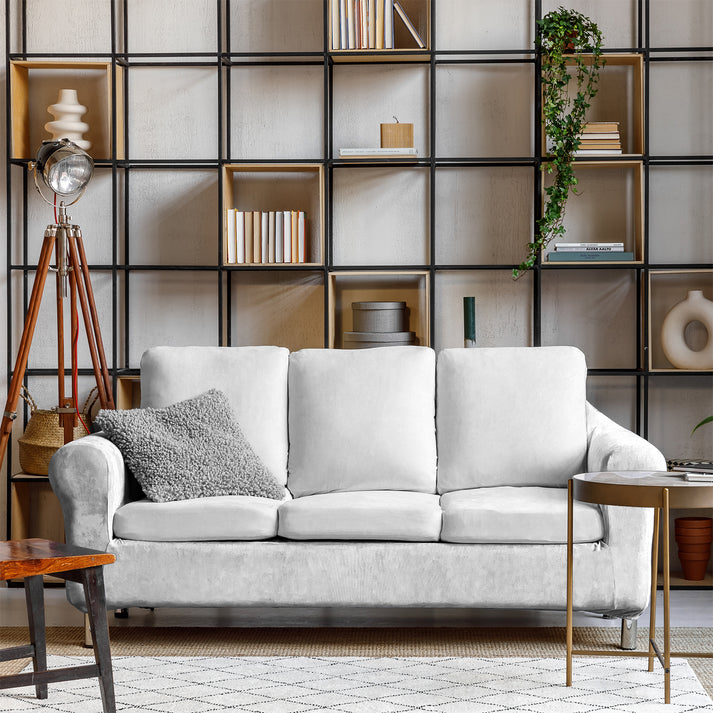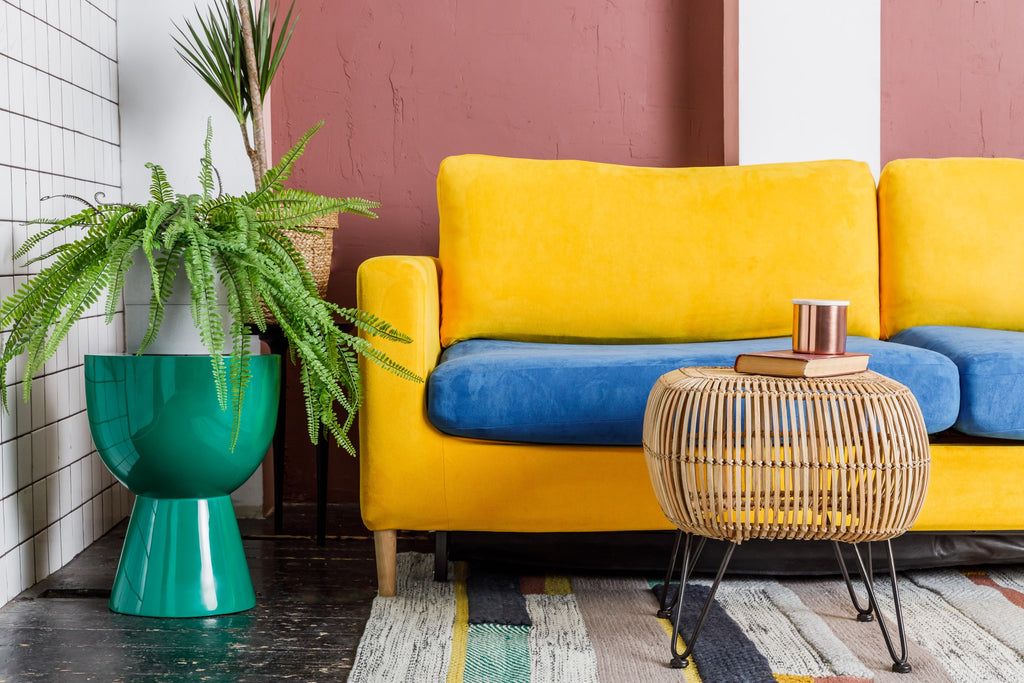It’s been a while since slipcovers were invented (over 200 years!), and for just as long, people have nurtured their delicate hopes of getting an instantly fresh, tailored look for their couch. Buying a sofa cover and then following the seller’s instructions line by line should be enough, right? Unfortunately, slipcover products often leave something to be desired, so an unofficial set of tried and tested tips and tricks has sprung up to help customers get their sofa look the way they want. This post uncovers most of these tricks, and offers further tips developed by the Homeleon team. We went so deep into this topic that we’re dreaming about solutions for wrinkling and tucking in our sleep!

How slipcovers usually look (left pic) vs their potential (right pic)
Summary FAQ/TL;DR
Assuming that this question is mostly related to ready-made slipcovers, the ones that fit best are stretchy and have multiple pieces for the base of the sofa and the cushion.
If you’ve already made your purchase, then there are tried tips and tricks to improve the fit:
- Tucking the excess fabric
- Securing it with foam rolls or pool noodles
- Using upholstery pins or velcro strips
- Trying additional stuffing
If you’re still considering the purchase, go for multi-piece stretch couch covers and make sure they have ties at the bottom and a specially sewn elastic band. Once you do that, just make sure to put on the slipcover the right way.
If you want the sofa cover to stay and stop slipping and riding up consider multi-piece slipcovers with ties and a specially sewn elastic band at the bottom. Otherwise, prepare to use tested tips and tricks:
- Tuck in the excess fabric
- Secure it with foam rolls or pool noodles
- Use upholstery pins or velcro strips
- Try additional stuffing
Simply stuff these into the crevices of the sofa along with the excess fabric.
Smooth out the fabric, pin the excess in hidden places such as the crevices or under the sofa frame.
Readily available options: choose different colors for the base of the couch and the cushions.
Custom options: depends on the company you order from, but usually you can get a custom fabric type, color and some minor accessories.
DIY: customize anything that your heart desires (keep in mind your skills and budget).
Keep reading to get the full picture.
Improving the Look Begins Before the Purchase
When shopping for a sofa slipcover, you will be choosing between a custom slipcover or a ready-made one.

Custom Slipcover
Custom sofa covers, if well made, should have no fit issues at all, but will typically be a harder hit on your wallet, starting in the range of $400-600 and running as high as a brand new couch. In this post, we assume that they’re worth their money and the look is fine. But even if it’s not, the fit tips for them would be more of a DIY or find-your-local-upholstery-shop post.
In the category of ready-made sofa covers, you will find a variety of fits, from a loose-fit (available in different non-stretch fabrics) to a tight-fit stretch slipcover (made in fabrics with good stretch).

Here’s where to start your decision-making. There are two essential first steps in choosing a slipcover for the optimal fit and look:
1. Choose a stretch slipcover
While it’s true that you should mind the style you’re going for (loose-fit can suggest a rustic style, whereas tight-fit better suits a more modern style), we really do believe that a stretch couch cover is a better choice overall than a loose one, since its fabric allows for more versatility while maintaining a decent look—stretch covers are often adaptable or universal enough to be used on multiple couch and cushion models, which is a bonus if you move a lot.
A loose-fit cover is basically a huge single sheet of cotton fabric that simply can’t stay in place for long, no matter how much effort you put in. If you want even a moderately pristine, unwrinkled, or neat look with a loose-fit slipcover, you would need to go with a custom-made or DIY one. Better stick to the tight-fit, we say.
Finally, the existing fit hacks and modifications that help ready-made sofa covers fit more snugly simply work better on stretch slipcovers due to its more adaptable material, so there’s less pain in achieving and maintaining the look you want.
2. Avoid one-piece slipcovers

One piece slipcover
They may have an attractive price tag, but they won’t deliver a look to be proud of. One-piece couch covers have the unsightly effect of a large sheet pulled over your entire couch, turning it into a kind of fabric mound. On the high end they still prominently announce themselves as bulky slipcovers, and on the lower end they are simply lumpy and sloppy. Even if you manage to make a one-piece cover look good by tucking in the excess fabric, just have a seat and move around a little, and you’ll find you need to tuck it all in again. And we’re not talking about energetic kids or pets here.
Consider using slipcovers that consist of at least separate couch base and cushion covers. They will provide a more aesthetic, put-together effect. Placing the cased cushions on top of the base cover helps hide excess material and also helps hold down fabric that might otherwise pull out. The more separately covered parts, the better the look.

These are the basics that you should nail to get a great foundation for a nice fit and look.
What Are the Classic Tricks to Keep Slipcovers in Place?
Tried and tested, these tips have their quirks, but they can still sometimes save the day.
-
Tucking the excess fabric into the couch folds or crevices.
A true classic of the slipcover community that keeps lots of people up at night with the question of ‘How to keep slipcovers tucked in’ once it doesn’t last long.
-
Foam rolls and pool noodles.
Another popular recommendation for getting a better couch cover fit is to wedge foam rolls or pool noodles into the crevices of the sofa (for example, behind the seat cushions) to help hold the fabric down.
While it is definitely an improvement, you’ll find that these insertions pop back up with infuriating frequency, especially with loose-fit sofa covers. (And trust us, it’s not always easy to gracefully explain that neon green pool noodle to your special visitor.) Stretch slipcovers hold onto these wedges and tucks better, since their materials are more flexible. Granted, you should probably strive for a slipcover with a good fit that doesn’t require you to shove strange objects into your couch in the first place—more on this below.
-
Upholstery pins.
Pinning excess fabric can be a good solution. Simply buy upholstery pins, smooth out the fabric, and secure it with pins in hidden places. One caveat here is that using pins comes with a risk of damaging your furniture, especially over time.
-
Velcro.
A DIY version of the upholstery pins is to sew Velcro strips to the couch and slipcover in order to secure them to each other.
-
Additional stuffing.
Another creative approach to solving fit problems: should your sofa arms be too thin, stuff some bath towels or batting into the arms of the slipcover. To avoid this extra step, choose stretch slipcovers, which conform better to a wide range of shapes.
Tips From People Who Have Tested Slipcovers Hundreds of Times
To avoid constantly struggling with slipcovers that keep slipping or riding up or pulling out of place (or banning all family and visitors from using the couch in a fit of fury), here are additional tips:
1. Install the slipcover the right way

The seams on both sides should be placed on the same parts of the sofa
When placing your sofa cover on, be sure to pay close attention to the seam positions and adjust them to match the edges of your sofa; keep an eye on symmetry of the slipcover seams; this will help you achieve a better silhouette.
2. Look for slipcovers with elastic bands sewn directly to the slipcover fabric

The elastic band is sewn right to the bottom of the cover
Currently, in many designs, the elastic band at the bottom of the slipcover is hidden within a fabric pocket, which allows the band to move around. We recommend searching for a sofa cover that has this band sewn directly to the cover’s fabric; this one small adjustment offers big gains in styling flexibility. When the band is sewn to the fabric, you can roll up the bottom of the slipcover to achieve the desired height, and the sewn-in band will anchor the look in place.
Is There More to a Slipcover’s Look?
Resolving fit issues with your slipcover will allow your design choices to stand out—instead of odd wrinkles and lumps (or the alarming tucking and smoothing tics you’ve developed). Now it’s time for the fun part—letting your inner interior design fiend roam free and finally getting not only the right fit but the interior design style you’ve always coveted.
You can start with going for trendy colors and patterns to get that vibe you always wanted. To add more, recent industry developments allow you to customize the color of your sofa cushions separately from the base —a powerful feature that can change the feeling and mood of your room in an instant and make it feel like your home and no one else’s.
If you’re into DIY, sofa covers can also be customized in an endless number of ways — dyeing the fabric, for example, or adding stitching, piping, and buttons. But these projects require a lot of time, effort, and skill, and often the overall effect retains a “crafty” or DIY feel.

Piping in slipcovers


